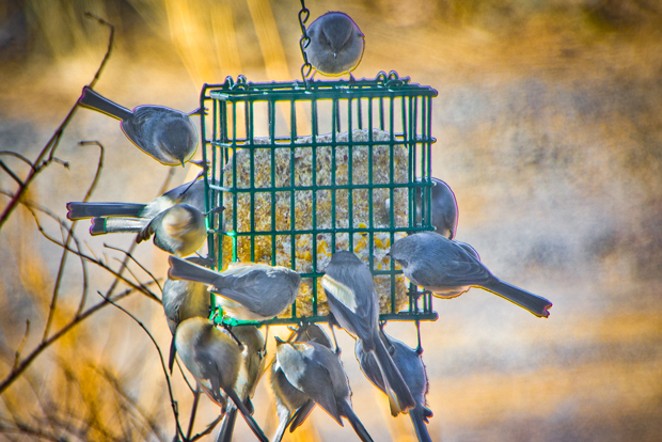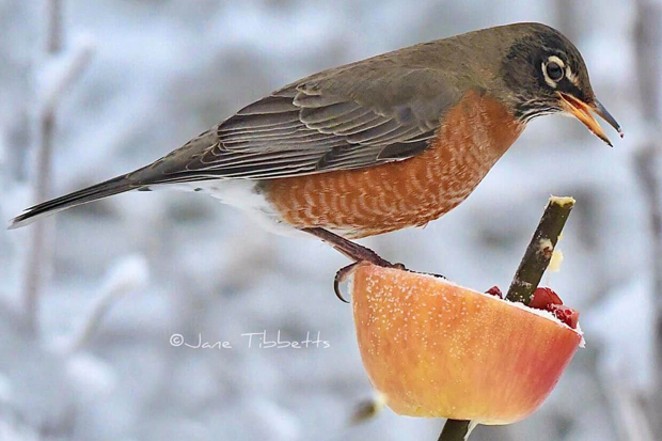Those Bushtits in Sue's photo, pigging out at our suet feeder, always bring the thrill of feeding wild birds alive in our souls. Don't know about you guys, but if you're having a slow and not-so-fun day, Bushtits will bring joy into your life!
Both Elise Wolf (a bird rehabber in Sisters), and my wife Sue and I have fed birds year 'round because of the pleasure it brings us seeing winged creatures up close and knowing with our help they — and we — can make it through some pretty tough times when birds are part of our lives. So, here are a few tips to ensure safe feeding practices:
To have the reserves to survive winter's frigid temperatures, birds need to eat foods that are the easiest to eat and digest, and that pack the highest nutritional and energy punch. These are the most sought-after seeds.
We'll start with millet, a natural low-fat, nutrient-dense staple food for doves, finches, juncos, quail and sparrows. Most of these are ground feeders, so just toss millet onto the ground (but not under the feeders); or for finches, put some in a tube feeder.
Next is sunflower, THE powerhouse of all the seeds. They pack a powerful and critical energy protein punch. Sunflowers without hulls (or 'hearts' as they're known by some suppliers) are great for birds that can't eat them whole (like woodpeckers) and/or physically cannot break into them (like Pine Siskins and bluebirds). It's a rare bird who doesn't like sunflower hearts. Even robins and bluebirds will enjoy this banquet in winter. It is even nice to toss some out for the quail and doves, as they too need those fat reserves.
Whole sunflowers can be held and chiseled easily by the nuthatches, chickadees, grosbeaks, jays and even finches. Some ground-feeder species with heartier gizzards, like turkey and quail, can eat these whole, though they take a bit more energy to digest.
Thistle is the "health" food of all the seeds. All of our finches will chow down on these. But, they only last a limited time, they dry out quickly and go rancid, and can be expensive.
Peanuts! Who doesn't love peanuts? Especially squirrels! But peanuts can carry aflatoxin, a mold that harms the livers in our birds. Feed these sparingly and use them up quickly. Put out only enough that is eaten in a day (either alone or in a mix). Never store peanuts for long.
Red millet, milo, canary seed or other hard grains are used as fillers. These are tossed out by the birds and attract rodents, and are readily eaten by the birds we want least at the feeders such as invasive house sparrows and starlings.
Cracked corn is enjoyed by many ground feeders, and, unfortunately, also by starlings, house sparrows, deer, raccoons and others we should not be feeding. Corn also has the highest levels of aflatoxin of all foods (human or animal). So, like peanuts, feed corn sparingly and in limited amounts.
Finally, give those winter fruit eaters a treat, too! An apple or orange cut in half, then scooped out a bit and filled with currants or berries will bring in cedar waxwings and robins, as well as other birds. Even our bluebirds will go for dark-colored berries.
And then there's suet, by far the bird food that helps our birds most in packing on the fat reserves. But, under some conditions it can get onto our bird's feet, heads and feathers. This could impair a bird's weatherproofing and insulation. Feathers act like a bird's own dry suit – and fats make the feathers stick together, making the bird open to cold. Cold birds are dead birds. Avoid this by feeding "true suet," not soft fats (see Safe Suet Feeding on Elise's Native Bird Care blog).
Always put suet in a cage or other enclosed feeder that doesn't allow the bird to get its body onto the suet. The commercial suet holder sold in bird supply stores, hardware stores and places like Bi-Mart are built so birds can get their beaks into the suet, and that's all.
Being a top-notch feathered-friend steward means also doing our best to prevent disease spread at the feeder. Clean those feeders at least every two weeks. Avoid those feeders that let birds potty right into the food (yuck!). Or those that cannot be sterilized easily. Move the feeders around the yard.
If possible, feed seeds alone or in certain combinations so that species are kept separate. Separation allows birds to each get more food and also results in less disease spread and fighting. My favorite is the Audubon Park 40lb box of mixed seed available at Costco. Wild Birds Unlimited also sells a wonderful variety of single and combination seeds and suet. Avoid cheap brands that contain a lot of filler.
Lastly, be nice to your seeds! Old, rancid sunflower hearts or seeds, dried-out thistle and moldy millet, corn and peanuts all cause illness and/or lower immunity. Poorly stored foods breed molds and fungi, become rancid, and have lower nutritional value. Aspergillosis molds develop in any wet or moist foods. So, keep it fresh, dry, cool and free of rodents.
Have a wonderful time Dear Bird People; it isn't just birds who love you when you're kind to Old Mother Nature.
For more information go to Elise Wolf's website, nativebirdcare.org, and scroll down on her blog tab for excellent bird feeding advice and instructions. Or send me an email at: [email protected].









